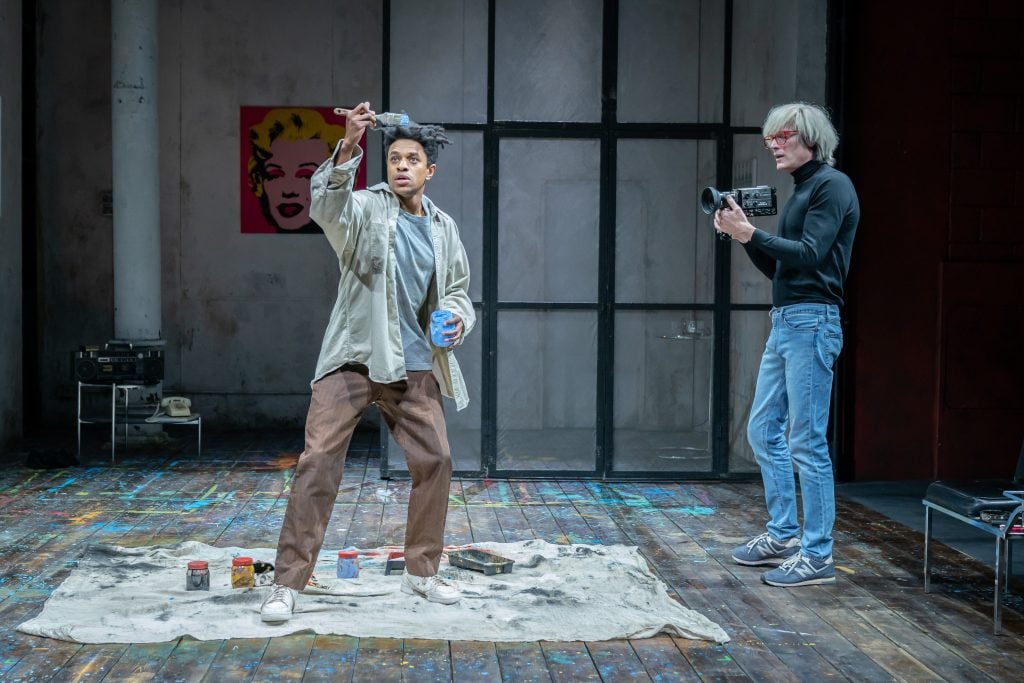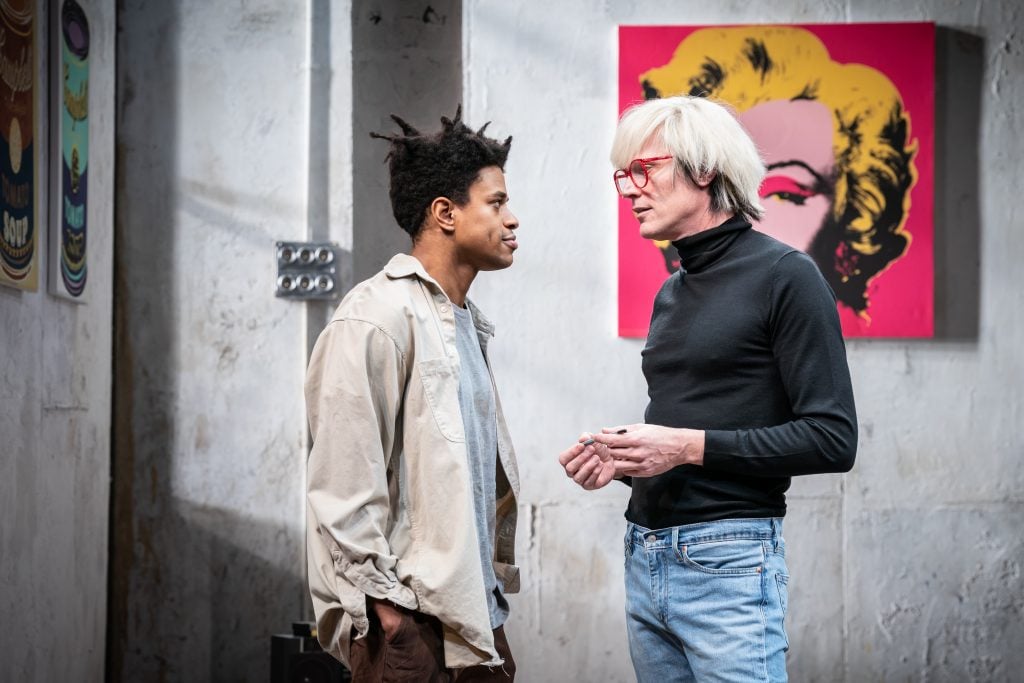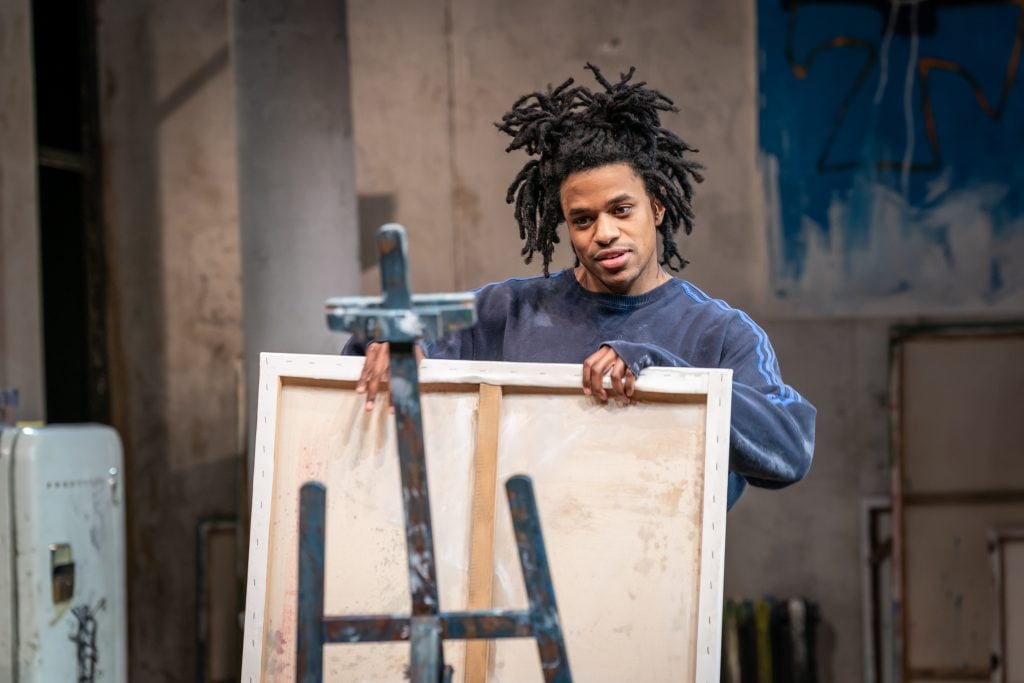Reviews
A Moving New Play About Jean-Michel Basquiat’s Collaboration With Andy Warhol Explores the Price of Artistic Immortality
Paul Bettany and Jeremy Pope star in 'The Collaboration.'

Paul Bettany and Jeremy Pope star in 'The Collaboration.'

Naomi Rea

Arriving at London’s Young Vic theater to see a new play about Andy Warhol and Jean-Michel Basquiat, I was thrust into the thick of 1980s New York. Basquiat’s signature SAMO tags were scrawled throughout the theater, while a record-scratching DJ was spinning hip-hop and disco in an effort to recreate the electricity of Studio 54. Onstage sat several reproductions of Basquiat paintings. “That’s the $110 million Basquiat—there,” I whispered to my partner as we sat down.
It’s hard to talk about Basquiat these days without nodding to the insatiable appetite for his work on the contemporary art market. Written by Anthony McCarten and directed by Kwame Kwei-Armah, The Collaboration—which, after its run in London ends on April 2 has its sights set on Broadway, before being adapted for the Hollywood screen—knows this.
The drama gives us a fictionalized take on the real collaboration between two titans of art history. It also advances something of a cautionary tale about the toll that the cynical forces of the art market take on artistic expression.
The action opens at Bruno Bischofberger’s eponymous downtown gallery. The Swiss art dealer and Warhol are taking in work by Basquiat, whose star is rising fast. “He’s mine now,” Bischofberger declares, as he announces a scheme to pair the two artists together in a selling exhibition, a cynical PR stunt which he hopes will generate a healthy profit.

Jeremy Pope and Paul Bettany in The Collaboration. ©Marc Brenner.
McCarten has written both artists as reluctant to collaborate, which is a simplification and less than historically accurate—but their hesitation opens the space to establish one of the central tensions of the play: both are disenchanted, in their own ways, with the mercantile machinations of the contemporary art market.
Paul Bettany’s laconic, whiny Warhol acridly bemoans the art world’s tendency to move onto the next hot thing. Jeremy Pope’s restless, babyish Basquiat, meanwhile, is already fed up with a “so white” establishment and his place within it as a Black man. Why can’t his talent survive on its own without hitching his wagon to Warhol’s star? And how come his graffiti is elevated to art that sells for $60,000 when equally talented contemporaries, such as his friend Michael Stewart, are arrested for defacing public property?
The titular collaboration itself begins in Andy Warhol’s ascetic studio, conjured in Anna Fleischle’s set design using recreations of Warhol’s Marilyns and Campbell Soup cans to adorn the walls. There, it becomes apparent that the two artists have very different ideas about what art should be.
Basquiat, who paints with spiritual fervor and believes paintings can be imbued with supernatural powers declares Warhol’s mechanically reproduced works to be bereft of soul. “I’m Dizzy Gillespie, blowing a riff, he’s one of those pianos that plays all by itself,” he shrugs. For his part, Warhol defends his theory of art: “I’m trying to make art that forces you to ignore it, the same way we’re ignoring life.”
The second act is where the play really comes to life, as the action jumps forward a couple of years to Basquiat’s messy downtown studio. The two men have grown closer. Their walls have come down and a few tender moments relay their character outside of their cultivated public personae. Basquiat’s infectious spirit has disrupted Warhol’s detached performance of himself, exposing his self-loathing and trauma after being shot a few years earlier.
Meanwhile, Basquiat is deteriorating. Grappling with his own trauma, a worsening heroin addiction, and the indifference of the art industry, he turns to nihilism, stuffing his fridge full of cash, Cristal, and caviar.
The climax of the play comes after Michael Stewart is brutally beaten by police in a subway station, and Basquiat begins to paint his friend in an effort to heal him—the work ultimately becomes Defacement (The Death of Michael Stewart). When Basquiat finds out that his friend has died from his injuries, he explodes at Warhol, distraught at his art’s inability to resurrect the dead.

Jeremy Pope in The Collaboration. ©Marc Brenner.
In a review of Julian Schnabel’s 1996 film, Basquiat, the curator Okwui Enwezor once derided the painter-turned-director for reducing the nuances of Basquiat’s life to a simplified narrative about a Black artist losing a “Faustian wager with fame, money and the white art world.” Schnabel was wrong; Basquiat didn’t sell his soul to the art market. But nearly three decades on, the market has taken it anyway. Basquiat the man has been totally swallowed up by Basquiat the brand. (Perhaps Schnabel’s film even played a role in cementing that brand.) McCarten and Kwei-Armah’s drama gets this. It resurrects Basquiat the man briefly—but doesn’t stop reminding us of what is to come either.
The drama comes to a close shortly after Warhol emotionally implores “Jean-Michel Basquiat… I order you to live forever…” There are layers of dramatic irony to this line; we all know Basquiat tragically died of a heroin overdose at 27. We also know that Warhol’s prophecy comes true—but in true Warholian fashion. The exhortation calls back to the first act, when Warhol hits us over the head with a more cynical message: “We’re not painters anymore, Jean. We’re brands. Well, you’re almost a giant brand, and after this exhibition with me you will be too. Then just watch the language change, Jean. People will have to ‘have you’ suddenly… And not you. Not you. Your paintings.”
The Collaboration doesn’t get into the lukewarm critical reception the pair’s joint show actually received, which played a role in Basquiat’s subsequent decline. The omission is possibly because to today’s audience, that hardly matters anymore. It’s the Basquiat brand that has been immortalized. He is today’s top-selling contemporary artist, and his work is used to sell everything from skateboards to Tiffany’s diamonds.
As the lights fade at the Young Vic, you hear the voice of Sotheby’s auctioneer Oliver Barker come over the speaker, a snippet of the historic moment in 2017 when that same skull painting I picked out at the beginning of the play sold for “$98 million!” That would be the highest ever price ever for a U.S artist—finally unseating Andy Warhol. It’s haunting.